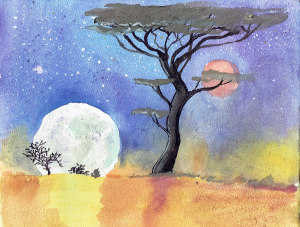Festival of the Moons
From World of Entorais Wiki
About
- Common Names
- Festival of the Moons, Festival of Stei, Balfagor's Night
- Overview
- As there are two moons in the sky of Entoras they feature prominently in both the folk lore and the religions of the peoples. In Waejir, the nights when both Rae and Nae are full are considered unique times when the veil between the lands of the living, and the lands of the unclaimed dead are thinnest. Allowing ghosts of persons not given a proper funeral to visit people in the dreams or even possibly waking moments. The festival takes place during the three nights closest matching a double full moon. A true conjunction of the full moons only occurs every 9 & 1/4 years (3330 days), and is cause for greater celebrations lasting a full tenday.
Religious
Balfagor
Devotees of Balfagor, and most other Waejirans will traipse about in elaborate masks depicting either of Balfagor's Stei, Rae or Nae, sometimes a dual mask, or even full costumes are worn. They dance to celebrate hopes, dreams, and divine wisdom delivered by the stei to deserving folk when they are sleeping.
- Waking dreams
- Many celebrants will partake of hallucinogenic substances or eschew sleep to bring on visions during waking moments during the celebrations. Waejirans believe that the dreams delivered by Rae and Nae during full moons are prophetic containing hints about a persons fate. Since both moons are full during these holy times, the night visions are believed to be especially revealing.
Neithur
Devotees of Neithur, the Waejiran god of the dead, take these times to perform ceremonies intended to guide these wayward souls to the afterlife. It is considered a sacred duty to help all souls find redemption through Neithur and eventual rebirth through Silat.
- Gathering the Dead
- Every temple of Neithur will send out one or more priests, whom parades about the city calling out to the dead to join with and accompany the procession back to Neithur's embrace. The course covers most of the city and is paced to last until dawn, at which time the procession will return to the temple. The sombre bronze death masks and ashen robes of the participating priests provides a stark contrast finery of the other celebrants. Lesser temple members may often dress ghosts, skeletons, and corpses following the priest about to encourage lost souls to join the parade and find salvation.
